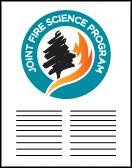United States Joint Fire Science Program
Document Type
Article
Date of this Version
2005
Citation
Project Active ID: 05-2-1-29
Abstract
As a result of this most recent SPB epidemic (1999-2003), thousands of hectares of dead pine trees have created wildfire-hazard conditions in the southern Appalachians. One of the challenges for land managers is how to return fire to these ecosystems after (1) nearly a decade of exclusion, and (2) the more recent SPB mortality enhanced fuel loads. Higher fuel loads have the potential to increase fire intensity and severity. At the extremes, fires of high intensity and severity can have a large effect on ecosystem structure and function. The objectives of our research were: (1) to quantify fuel load reduction methods (pine overstory felling, material left on site followed by prescribed fire; prescribed fire only; and no treatment) in pine/hardwood forests heavily impacted by southern pine beetle induced tree mortality, and (2) to evaluate the effects of further restoration treatments including planting shortleaf (Pinus echinata) pine and seeding native bluestem grasses on ecosystem structure and function in these pine-hardwood forests. Eight sites on the Cherokee National Forest, eastern Tennessee were chosen to evaluate restoration of shortleaf pine ecosystems. Four sites were cut+burn (2 dry, 2 sub-mesic), two sites were burn only, and two sites were used as references. All eight sites had substantial pine mortality before the initiation of fuel treatments (Figure 1). Sites were cut in summer 2005 and burned in March 2006. All site measurements for vegetation composition and diversity, carbon and nitrogen pools, soil and soil water chemistry, and success of planted pine and bluestem grasses for the pre-treatment (2005) and two years post-treatment (2006, 2007) have been completed. We have provided demonstrations and tours to user groups, oral and poster presentations at scientific meetings, and three published manuscripts (2 proceedings and 1 peer reviewed). In addition, three peer-reviewed manuscripts, one MS thesis, and one proceedings paper are in progress (see Deliverables table below).
Included in
Forest Biology Commons, Forest Management Commons, Natural Resources and Conservation Commons, Natural Resources Management and Policy Commons, Other Environmental Sciences Commons, Other Forestry and Forest Sciences Commons, Sustainability Commons, Wood Science and Pulp, Paper Technology Commons



Comments
U.S. Government Work